Heat Exposure Impacts Motor-Cognitive Abilities
The summer solstice is approaching, and in many regions, this also means the arrival of higher temperatures. A new study from the Heat-Shield project at the University of Copenhagen assessed how prolonged heat exposure impacts motor-cognitive functions. The results of this study were published last month in Scientific Reports. According to the study, prolonged head exposure to strong sunlight can significantly impair cognitively dominated functions and coordination of complex motor tasks.
The study reports that about half of the world's population lives in regions impacted by environmental heat stress, affecting health and productivity. Healthy adults experience discomfort and decreased physical work capacity. Vulnerable populations, such as senior citizens, are at higher mortality risk during heatwaves. These negative impacts are expected to worsen because of global climate change.
An article from the University of Copenhagen (UCPH) suggests that previous impacts of prolonged head exposure to sunlight may have been underestimated. Professor Lars Nybo is the project coordinator in the Department of Nutrition, Exercise, and Sports at the University. He states, "the novelty of the study is that we provide evidence that direct exposure to sunlight—especially the head—impairs motor and cognitive performance." Additionally, he reports that "the decline in motor and cognitive performance was observed at 38.5 degrees Celsius, which is a 1-degree lower body temperature than previous studies have shown, which is a substantial difference."
Study participants included eight healthy, active males aged 27 to 41. According to the UCPH article, the motor-cognitive test included four different computer math and logical tasks that relied on fine motor precision. To simulate environmental heat, four lamps were positioned around the lower-body and head (avoiding direct eye exposure). The study reports that participants were instructed to be hydrated and abstain from alcohol and strenuous exercise 24-hours before their experiments. Throughout the tests, markers of rising brainstem temperature were evaluated.
According to the University of Copenhagen, the Heat Shield project addresses the negative impacts of workplace heat stress on health and productivity in five key industries: manufacturing, construction, transportation, tourism, and agriculture. This project is funded by the European Union and includes twelve research institutions and other stakeholders across the EU.
This study's findings have health and safety implications for workers in industries such as agriculture, construction, and transport. The researchers suggest that future studies must include radiative heating of the head and neck, specifically when addressing impacts of environmental heat stress and consideration of specific head protection.
Sources: University of Copenhagen, Scientific Reports










